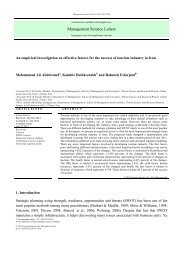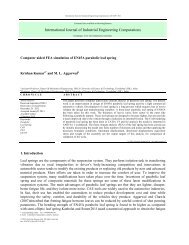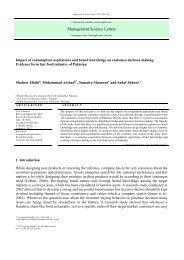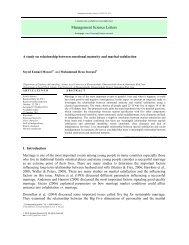PDF (276 K) - Growing Science
PDF (276 K) - Growing Science
PDF (276 K) - Growing Science
You also want an ePaper? Increase the reach of your titles
YUMPU automatically turns print PDFs into web optimized ePapers that Google loves.
M. Kazemi et al. / International Journal of Industrial Engineering Computations 3 (2012)<br />
incurs earliness penalty and no tardiness penalty, also imposes interruption penalty in addition to<br />
work-in-process holding cost because of the interruption happened in position 9.<br />
M<br />
5 8 10 12 15 20<br />
. . . J2 J2 J5 J5 J6 J6 J6 J5 J5 J5<br />
20 25 30 32<br />
Fig. 4. Job schedules<br />
Table 4<br />
Objective function and its cost components<br />
OFV Earliness Tardiness Work-in-process Interruption<br />
950 240 550 139 21<br />
Table 5 presents the solution obtained for each job and it contains the starting and completion time,<br />
number of interruptions and flow time. Furthermore, tardiness/earliness penalty imposed by each job<br />
is calculated in Table 5.<br />
Table 5<br />
The solution obtained for each job<br />
Job number<br />
Starting<br />
Time<br />
Completion<br />
Time<br />
No. of<br />
interruptions<br />
Flow time<br />
Tardiness<br />
Penalty<br />
Earliness<br />
penalty<br />
1 4 9 1 4 – 9 0 2*80$<br />
2 7 22 1 7 – 22 10*40 0<br />
3 8 12 1 8-12 0 1*80$<br />
4 13 17 0 13-17 0 0<br />
5 25 32 1 25-32 3*50 0<br />
6 27 29 0 27-29 0 0<br />
We implement the sensitive analysis of model by increasing the interruption cost of job 3 from 6 to<br />
300. The job schedules, objective function and the solution obtained for each job is presented in Fig 5<br />
and tables 6 and 7, respectively. Increasing in the interruption cost of job 3 causes that model tries to<br />
prevent interruption in processing of job 3. As a result, the flow time of jobs 1, 2 and 4 are increased.<br />
As we can see, job 3 is processed without any interruption and the flow time of jobs 1, 2 and 4 are<br />
increased from 6, 16 and 5 to 10, 17 and 6, respectively. Also the tardiness of job 1, 2 and 4 are<br />
increased. By comparing the objective function values presented in Tables 4 and 6, we can<br />
understand that in spite of processing job 3 without any interruption, increased flow time of jobs 1<br />
and 2 raise the objective function from 950 to 1222.<br />
M<br />
J1<br />
J1 J1 J2 J3 J1 J3 J3 J3 J4 J4 J4 J4 J4 J2 J2 J2<br />
J1 J1 J2 J1 J3 J3 J3 J3 J4 J1 J4 J4 J4 J4 J2 J2<br />
5 10 15 20<br />
. . . J2 J2 J2 J5 J5 J6 J6 J6 J5 J5 J5<br />
20 25 30 32<br />
Fig. 5. Job schedules with increased interruption cost<br />
331








